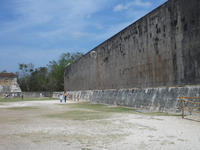You are in: North America -> Mexico -> Pre-Hispanic City of... , and traditional search or Image Gallery will yield results of this site only
Pre-Hispanic City of Chichén-Itzá
| Site number: | 483 |
|
| Type of site: | Cultural | |
| Date: | 1000 years ago | |
| Date of Inscription: | 1988 | |
| Location: | North America, Mexico, Etat de Yucatan, Municipalité de Tinum | |
Up to 75 images are shown here. Click on each for more details or on Image Gallery for more images.
Six official UN languages:
Arabic,
Chinese,
English,
French,
Russian,
Spanish
Other languages: Bulgarian, Catalan, Croatian, Czech, Danish, Dutch, Esperanto, Finnish, German, Greek, Hungarian, Indonesian, Italian, Japanese, Korean, Lithuanian, Norwegian-bokmål, Polish, Portuguese, Quechua, Serbian, Swedish, Tamil, Thai, Turkish, Vietnamese
Other languages: Bulgarian, Catalan, Croatian, Czech, Danish, Dutch, Esperanto, Finnish, German, Greek, Hungarian, Indonesian, Italian, Japanese, Korean, Lithuanian, Norwegian-bokmål, Polish, Portuguese, Quechua, Serbian, Swedish, Tamil, Thai, Turkish, Vietnamese
| Description: | The sacred site of the Pre-Hispanic City of Chichén-Itzá used to be among the greatest Mayan centres on the Yucatán peninsula. Various peoples have left their mark upon the city throughout its almost 1,000-year history. The concept of the world and the universe of the Maya, Toltec and Iztec is disclosed within their stone monuments and artistic works. Chichen-Itza is one of the most significant illustrations of the Mayan-Toltec civilization in Yucatán, specifically with its fusion of Mayan construction techniques with those that were novel at the time in central Mexico. Quite a few buildings have survived to this day, for instance the Warriors' Temple, El Castillo and the circular observatory identified as El Caracol. --WHMNet paraphrase from the description at WHC Site, where additional information is available. | |
| Chichen Itza (pronounced /tʃiːˈtʃɛn iːˈtsɑː/[1]) (from Yucatec Maya: chich'en itza', "At the mouth of the well of the Itza") is a large pre-Columbian archaeological site built by the Maya civilization located in the northern center of the Yucatán Peninsula, present-day Mexico. Chichen Itza was a major regional center in the northern Maya lowlands from the Late Classic through the Terminal Classic and into the early portion of the Early Postclassic period. The site exhibits a multitude of architectural styles, from what is called “Mexicanized” and reminiscent of styles seen in central Mexico to the Puuc style found among the Puuc Maya of the northern lowlands. The presence of central Mexican styles was once thought to have been representative of direct migration or even conquest from central Mexico, but most contemporary interpretations view the presence of these non-Maya styles more as the result of cultural diffusion. Archaeological data, such as evidence of burning at a number of important structures and architectural complexes, suggest that Chichen Itza's collapse was violent. Following the decline of Chichen Itza's hegemony, regional power in the Yucatán shifted to a new center at Mayapan. The ruins of Chichen Itza are federal property, and the site’s stewardship is maintained by Mexico’s National Institute of Anthropology and History (Instituto Nacional de Antropología e Historia, INAH). The land under the monuments, however, is privately-owned by the Barbachano family. --Wikipedia. Text is available under the Creative Commons Attribution-ShareAlike License. | ||
| Source: | http://whc.unesco.org/en/list/483 | |
| Source2: | http://whc.unesco.org/en/list/483/video | |
| Reference: | 1. UNESCO World Heritage Center, Site Page. | |


























